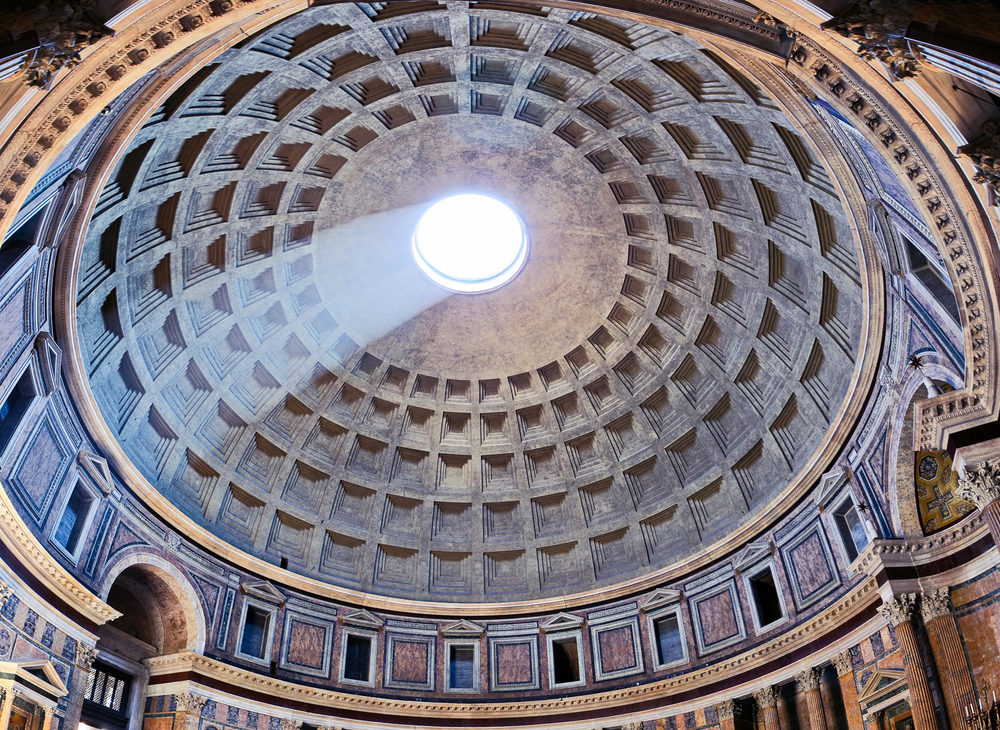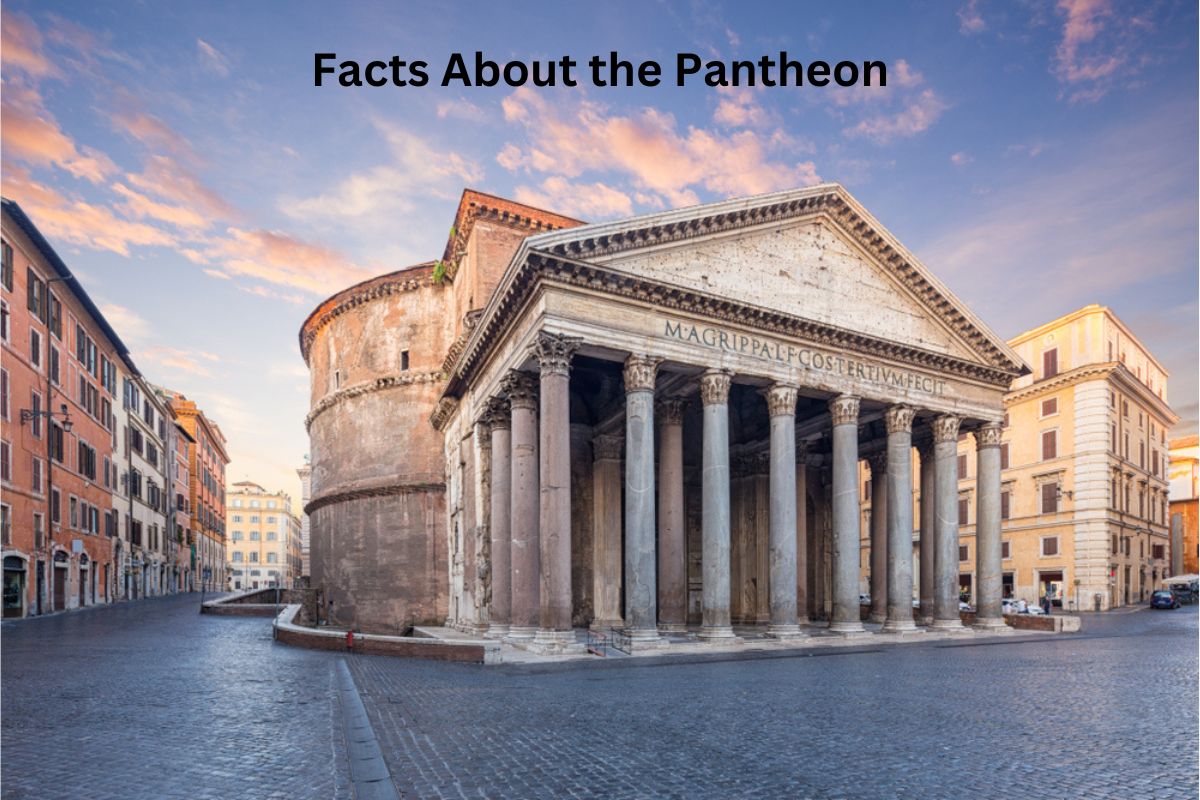The Pantheon is an ancient Roman temple located in Rome, Italy. Originally built as a temple dedicated to all the gods of pagan Rome, it stands as a testament to the architectural prowess of the Roman Empire.
The current structure is a reconstruction commissioned by Emperor Hadrian in 126 AD, after the original temple built by Marcus Agrippa was destroyed.
With its massive dome, unique oculus, and captivating interior rotunda, the Pantheon has captivated visitors for centuries. Converted into a Christian church, it now serves as the Basilica of Santa Maria ad Martyres.
Today, the Pantheon is a popular tourist attraction, renowned for its historical significance and architectural brilliance.
Pantheon Facts
1. Located in Rome, Italy
The Pantheon is situated in the heart of Rome, specifically in the Campus Martius region, near the Piazza della Rotonda. Its central location makes it easily accessible and a prominent landmark within the city.

2. Originally built as a Roman temple
The Pantheon was originally constructed as a temple dedicated to all the gods of ancient Rome. It was commissioned by Marcus Agrippa, a Roman general and statesman, during the reign of Emperor Augustus. The exact date of its construction is believed to be between 27 and 25 BC.
3. Commissioned by Marcus Agrippa and rebuilt by Emperor Hadrian
Marcus Agrippa was responsible for the initial construction of the Pantheon. However, the current structure that stands today is largely the result of a rebuild ordered by Emperor Hadrian in 126 AD.
Also Read: Facts About the Roman Forum
Hadrian aimed to reconstruct the temple in a grander and more monumental style, while still preserving Agrippa’s original design.
4. Name means “all gods” in Greek
The name “Pantheon” is derived from the Greek words “pan,” meaning “all,” and “theos,” meaning “god.” This name reflects the original purpose of the temple, which was to honor and worship all the gods of ancient Rome.
Also Read: The Colosseum Facts
The Pantheon was intended as a grand monument that celebrated the diversity and vastness of the Roman pantheon of deities. The name captures the inclusive nature of the temple and its significance as a place of reverence for the entire pantheon of gods worshiped by the Romans.
5. Has one of the largest unsupported domes in the world
One of the most remarkable features of the Pantheon is its dome, which is a marvel of ancient engineering. The dome is made of concrete and is considered one of the largest unreinforced concrete domes in the world.
It has a diameter of 43.3 meters (142 feet) and stands as a testament to the architectural prowess of the Roman Empire.

6. Dome has a circular opening called the oculus
The dome of the Pantheon features a unique circular opening at its apex known as the oculus. The oculus serves as the primary source of light for the interior of the building.
It measures approximately 8.7 meters (28 feet) in diameter and provides a captivating view of the sky. Interestingly, the oculus also allows rainwater to enter the building.
However, a sophisticated drainage system comprising small holes in the marble floor efficiently channels the water away.
7. Interior features a remarkable rotunda with niches for statues
The interior of the Pantheon is designed in a circular space known as the rotunda. The rotunda boasts a coffered ceiling with recessed square panels, creating a visually stunning effect.
Also Read: Parthenon vs Pantheon
The walls of the rotunda are adorned with niches that were once home to statues of various gods and emperors.
These statues, however, were removed during the Christian conversion of the Pantheon, leaving the niches as decorative elements that add to the architectural splendor of the space.
8. Converted into a Christian church after the fall of the Roman Empire
After the fall of the Roman Empire and the decline of pagan worship, the Pantheon was converted into a Christian church.
In 609 AD, Pope Boniface IV consecrated the Pantheon as the Basilica of Santa Maria ad Martyres. This conversion played a crucial role in preserving the building from destruction during the Middle Ages and ensured its survival to the present day.
9. Burial place of notable individuals like Raphael
The Pantheon houses the tombs of several significant figures. One of the most famous individuals buried there is the renowned Italian artist Raphael, who is interred in a niche on the right side of the rotunda.
Additionally, the Pantheon serves as the final resting place for Italian kings and queens, including Vittorio Emanuele II and Umberto I, as well as Queen Margherita.
10. Influenced the design of other famous buildings and is a popular tourist attraction
The architectural design of the Pantheon has had a profound impact on subsequent buildings throughout history. Its monumental dome and innovative construction techniques served as a model for numerous domed structures worldwide.
Notable examples include the Dome of the Rock in Jerusalem, which was inspired by the Pantheon’s dome, and the United States Capitol building in Washington, D.C., whose dome draws inspiration from the Pantheon’s grandeur.
The Pantheon is a major tourist destination and attracts millions of visitors each year. Its historical significance, architectural magnificence, and cultural value make it one of the most iconic landmarks in Rome.
Tourists are drawn to the Pantheon’s impressive interior, awe-inspiring dome, and the opportunity to explore its rich history. It remains an enduring symbol of ancient Roman engineering and artistry.
